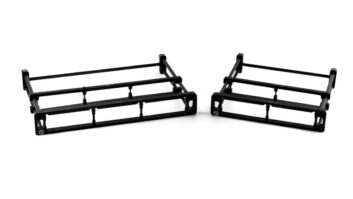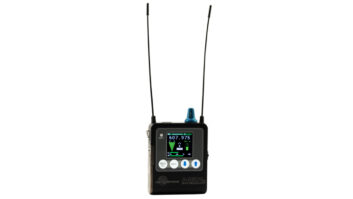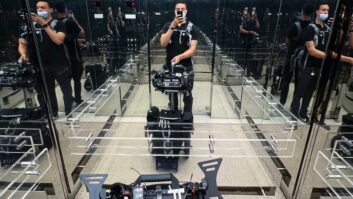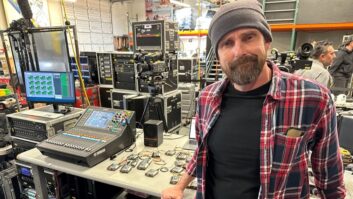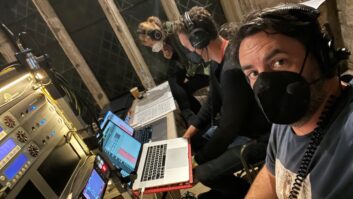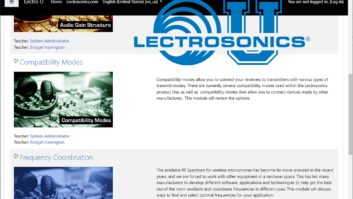RIO RANCHO, NM—Beginning its 40th anniversary celebration at NAB, Lectrosonics has a unique story to tell of innovation and selfsufficiency. Based just outside of Albuquerque, New Mexico, the headquarters for the wireless audio and DSP-based audio processing specialists contains the entirety of Lectrosonics’ management, sales, R&D and manufacturing operations built on a steadily expanding footprint. “Made in the USA by a Bunch of Fanatics”—a motto first suggested in jest in conjunction with a photo of (stuffed) Bornean bearded pig mouthing a Lectrosonics portable receiver (you can visit him at gnarlywireless.com)—the slogan was officially embraced as representative of the company ethos.
Lectrosonics was founded in 1971 by Tom Gilmer, the name derived from “lectern,” the first products being the Sound Projector line of podium and portable PA systems, including a luggable, batterypowered, speaker in a box with a mic attached on a coiled umbilical (evolved now into the fourth-generation “Long Ranger” products that add wireless for the mic connection). In 1981, the company began its modern phase under the leadership of technologist and high-tech manufacturing professional, John Arasim. The since consistently profitable company took advantage of the low land prices and businessfriendly atmosphere in Rio Rancho to buy land that allowed them to move from the original aging Quonset hut operation to purpose-built facilities on a tract of property that allowed for subsequent, ongoing and future expansion.
The “Gnarly Wireless” branding campaign shows the lighter side of a serious company that also knows how not to take themselves too seriously. “We have fun,” was one of the core company rules shared with Lectrosonics VP of sales Gordon Moore when he joined the company 22 years ago, alongside a business philosophy of building the best product they know how, while charging enough to finance their own expansion. From his background in retail, Moore recalls that when times got tight, like in the current economy, “where our sales increased was on the quality gear. People get more cautious about what they spend, but they are more willing to spend on the quality stuff. It’s suddenly not money they can afford to throw away or take a risk with or just stick with the known high-end products, and I think that’s what we’re seeing here is people are just saying, ‘Money’s tight, let’s make sure we get the best we can get through money that we’re spending.’” The philosophy of manufacturing the “best product they know how” has served Lectrosonics well leading into and through the current market conditions. “We’ve been in this constant demand-exceeding- supply situation for well over a year, and I don’t see any end to it at this point. Everything is just peaking, and it’s great.”
Lectrosonics is a remarkably selfcontained manufacturing facility, from engineering and design, to the machining of raw materials, to finish and etching of completed device housings, to highly automated surface- mount, circuit-board layout and assembly, to test and quality control. That has its limiting aspects, says Moore: “When you are as vertically oriented as we are and do so much internally…the best we can do is about a 25 percent [annual] growth rate. You go beyond that, and it really puts a strain on things because you have to have to start acquiring equipment and people at a pace that becomes hard to sustain. Not financially, but just logistically speaking.”
The technical proficiency of Lectrosonics’
sales and marketing teams is illustrated by
the RF spectrum analyzer on the back of
VP of sales Gordon Moore’s desk, which
he’s been using to monitor activity in the
700 MHz band recently purged of television
and wireless microphone signals. That said, while many manufacturers are facing challenges from, and turning to, offshore manufacturing to stay competitive, Lectrosonics is actually growing in part because of export expansion into countries like China, based on its proprietary technologies and quality. “The edge and the angle is because our hardware is unique,” Moore explains, citing as an example Lectrosonics’ Digital Hybrid Wireless that uses digital signal processing (eliminating the “weak link” of analog wireless, the compander) yet still transmitting on traditional wireless frequencies. “Nobody builds anything like it,” he continues, “and it’s not something you can easily copy; you can copy the circuit board, but the firmware can’t be off-loaded.”

Lectrosonics VP of engineering Bob Cunnings says the process of product refinement is constant. “It’s not uncommon for us to turn around firmware updates in 48 hours if there’s some urgent need,” he explains, adding that hardware changes can also be rapidly introduced. “The price is that it complicates internally here our manufacturing process because we’re constantly introducing in the manufacturing process change orders [and] refinements.”
Along with self-contained manufacturing, in-house engineering expertise is a major strength of Lectrosonics. “We’ve got quite an interesting mix in the engineering department,” says Cunnings, “because we have experts in various fields here, RF design, digital and analog and then we have expertise in DSP algorithm design as well as general-purpose computing. So we’ve had to develop with a relatively small staff, a very broad range of expertise because the products unite a number of technologies.”
But while that staff is “relatively small,” it is also disproportionately large given the size of Lectrosonics, giving the company a leadership role in miniaturization and highly efficient digital processing. “We have not been afraid to design sophisticated DSP-based products and support them with firmware that allows us to process the audio, invent new categories of features or improve things that were once done in the analog domain but can be done better in the digital domain,” says Cunnings. “And that has transferred to our installed product lines which are now at the very leading edge in terms of the selection of DSP parts”—so much so, he says, that Lectrosonics engineers are among the first to have access to the latest DSP components, even helping refine the parts before mass production.
The DSP prowess Lectrosonics developed in wireless was applied to the installed sound market a few years back, with the introduction of the Aspen line of networked sound controller/processors. Twenty-seven- year Lectrosonics veteran, VP of marketing, Bruce Jones (the photographer behind the Gnarly pig and the author of the Fanatics slogan), says that while “our Aspen processors just eat the competitors for lunch,” the Aspen line is just hitting its stride in the market at the end of a steep initial curve of awareness—customer education being crucial as Aspen sets new benchmarks that are “almost too good to believe, literally.”
Aspen is an example of how a nimble and forward-looking company can look to the future and refine a technology, then build the market for it. A fairly narrow-range product like the D4 quad digital wireless repeater can be developed as a platform for future applications—that foundation now built upon with the new Quadra wireless, multichannel digital IEM system, a bona-fide groundbreaking product operating outside of traditional and threatened wireless frequencies and offering unparalleled throughput latencies.
Innovation, continually refined designs, flexibility, a commitment to uncompromised quality, selfsufficiency, a “customer-centric” philosophy, a strong sense of teamwork and employee retention-based individual empowerment, expansion into horizontal markets technologically and into international sales and distribution markets—the gestalt of what has fueled Lectrosonics’ success and growth provides these “Fanatics” a solid foundation from which to reach towards future milestones.
Lectrosonics, lectrosonics.com
